Information Technology Reference
In-Depth Information
Fig. 1.
An example of a Colored Trails game played by three agents. Agents
A
1
and
A
2
on the left are allocators. They both start at the tile marked 1, and aim to get as
close to tile 16 as possible. Agent
R
on the right is a responder. She starts at tile 4 and
tries to get as close as possible to tile 13.
handing in a chip of the same color as the destination tile. Each player is also
assigned a goal location, which the player has to approach as closely as possible.
To achieve this goal, players are allowed to trade chips among each other.
Figure 1 shows an example of a Colored Trails setting, in which there are three
players, each with their own set of chips. Agent
A
2
on the left, for example, has
one dotted chip, one gray chip, and three striped chips. If agent
A
2
is at the tile
marked as 3, he can therefore move to tile 2 if he hands in one of his striped
chips. However, if agent
A
2
wishes to move to tile 7, he will have to make a trade
with either agent
A
1
or agent
R
to obtain a black chip.
Depending on the aspect of negotiation that is being investigated, scoring rules
vary. Following [14], a player that reaches his goal tile is awarded 50 points. If
a player is unable to reach his goal tile, he pays a penalty of 10 points for each
tile in the shortest path from his current location to his goal location. To focus
our research on the effectiveness of higher-order theory of mind in mixed-motive
settings, players do not receive any points for unused chips. This way, players
have to compete to obtain the chips they need to reach their goal location, and
cooperate to find a mutually beneficial trade.
We consider a standard Colored Trails setup in which players are put into
either the role of
allocator
or the role of
responder
[14]. An allocator can offer
to trade some of his chips against some of the responder's chips. The responder
does not make trades of her own. Instead, she chooses whether to accept an offer
made to her by an allocator. We focus our attention on the scenario that includes
two allocators and one responder. Here, allocators may benefit from considering
the goal of the responder, as well as possible offers of the competing allocator.
The Colored Trails game is an example of a mixed-motive situation, in which
players can generally improve their score by trading chips with another player.
Since mutually beneficial trades may exist, an allocator may benefit from using
theory of mind, and explicitly consider the goals of his trading partner. We
expect that allocator agents capable of using theory of mind will outperform
agents that are unable to consider the goals of other agents. Furthermore, we
also expect that in cases where there are multiple allocators, allocator agents
perform better when they are of a higher order of theory of mind.



